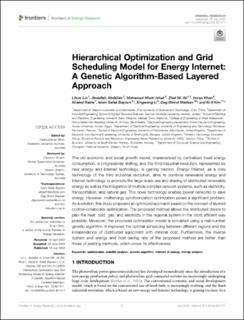| dc.contributor.author | Lin, Lihua | |
| dc.contributor.author | Abdallah, Abdallah | |
| dc.contributor.author | Ishak, Mohamad Khairi | |
| dc.contributor.author | Ali, Ziad M. | |
| dc.contributor.author | Khan, Imran | |
| dc.contributor.author | Rabie, Khaled | |
| dc.contributor.author | Safak Bayram, Islam | |
| dc.contributor.author | Li, Xingwang | |
| dc.contributor.author | Madsen, Dag Øivind | |
| dc.contributor.author | Kim, Ki-Il | |
| dc.date.accessioned | 2022-11-28T14:14:34Z | |
| dc.date.available | 2022-11-28T14:14:34Z | |
| dc.date.created | 2022-09-21T13:53:09Z | |
| dc.date.issued | 2022 | |
| dc.identifier.citation | Lin, L., Abdallah, A., Ishak, M. K., Ali, Z. M., Khan, I., Rabie, K., Safak Bayram, I., Li, X., Madsen, D. Ø., & Kim, K.-I. (2022). Hierarchical Optimization and Grid Scheduling Model for Energy Internet: A Genetic Algorithm-Based Layered Approach. Frontiers in Energy Research, 10, Artikkel 921411. | en_US |
| dc.identifier.issn | 2296-598X | |
| dc.identifier.uri | https://hdl.handle.net/11250/3034541 | |
| dc.description.abstract | The old economic and social growth model, characterized by centralized fossil energy consumption, is progressively shifting, and the third industrial revolution, represented by new energy and Internet technology, is gaining traction. Energy Internet, as a core technology of the third industrial revolution, aims to combine renewable energy and Internet technology to promote the large-scale use and sharing of distributed renewable energy as well as the integration of multiple complex network systems, such as electricity, transportation, and natural gas. This novel technology enables power networks to save energy. However, multienergy synchronization optimization poses a significant problem. As a solution, this study proposed an optimized approach based on the concept of layered control–collaborate optimization. The proposed method allows the distributed device to plan the heat, cold, gas, and electricity in the regional system in the most efficient way possible. Moreover, the proposed optimization model is simulated using a real-number genetic algorithm. It improved the optimal scheduling between different regions and the independence of distributed equipment with minimal cost. Furthermore, the inverse system and energy and cost saving rate of the proposed method are better than those of existing methods, which prove its effectiveness. | en_US |
| dc.language.iso | eng | en_US |
| dc.rights | Navngivelse 4.0 Internasjonal | * |
| dc.rights.uri | http://creativecommons.org/licenses/by/4.0/deed.no | * |
| dc.title | Hierarchical Optimization and Grid Scheduling Model for Energy Internet: A Genetic Algorithm-Based Layered Approach | en_US |
| dc.type | Peer reviewed | en_US |
| dc.type | Journal article | en_US |
| dc.description.version | publishedVersion | en_US |
| dc.rights.holder | © 2022 Lin, Abdallah, Ishak, Ali, Khan, Rabie, Safak Bayram, Li, Madsen and Kim. | en_US |
| dc.source.pagenumber | 12 | en_US |
| dc.source.volume | 10 | en_US |
| dc.source.journal | Frontiers in Energy Research | en_US |
| dc.identifier.doi | https://doi.org/10.3389/fenrg.2022.921411 | |
| dc.identifier.cristin | 2053954 | |
| dc.source.articlenumber | 921411 | en_US |
| cristin.ispublished | true | |
| cristin.fulltext | original | |
| cristin.qualitycode | 1 | |

